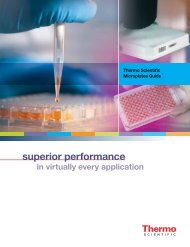PeloBiotech
Create successful ePaper yourself
Turn your PDF publications into a flip-book with our unique Google optimized e-Paper software.
www.pelobiotech.com<br />
HUVECs have been used in the cultivation of cardiovascular grafts to study fibrinolytic parameters. The versatility of<br />
HUVECs is evident in their application in various fields such as medicine, biology, and endothelial dysfunction research.<br />
HUVECs have also been employed in the investigation of signaling pathways, including the lactate/NFkB/IL-8 pathway,<br />
which plays a crucial role in tumor metabolism and angiogenesis. HUVECs have been utilized to study the interaction<br />
between TRPV4 and KCa2.3 in the context of hypertension treatment.<br />
The significance of HUVECs in research is further emphasized by their use in the study of autophagy, apoptosis, and<br />
oxidative stress, as well as their role in modeling atherosclerosis and investigating protective mechanisms against injury.<br />
GFP-tagged with liposomes and viruses HUVECs offer real-time visualization of subcellular structures, facilitating studies<br />
on cellular dynamics and interactions. Conditionally immortalized umbilical cord MSCs are valuable for regenerative<br />
medicine research, exploring their potential in tissue engineering and cell-based therapies.<br />
Breast<br />
We isolate epithelial cells, fibroblasts, endothelial cells, breast cancer cells from tumors, as well as patient-derived<br />
xenograft (PDX) cells, and breast cancer-associated fibroblasts from breast tissue. These samples are sourced from<br />
various species. The use of epithelial cells, fibroblasts, endothelial cells, breast cancer cells from tumors, patient-derived<br />
xenograft (PDX) cells, and breast cancer-associated fibroblasts from breast tissue are diverse and significant in various<br />
research and clinical applications. Epithelial cells have been utilized in the separation of breast cancer cells from peripherally<br />
circulating blood, particularly through the use of antibodies fixed in microchannels, which enables the isolation of breast<br />
cancer cells at an early stage of tumor growth and metastasis.<br />
Fibroblasts have been employed in regenerative medicine due to their potential to provide appropriate cross-talk and<br />
extracellular matrix (ECM) production to maintain tissue homeostasis and enable repair. Additionally, fibroblasts have<br />
been used in the treatment of skin disorders, such as recessive dystrophic epidermolysis bullosa, and have been applied<br />
as a biological dressing in wound beds. Furthermore, fibroblasts have been studied for their paracrine anti-fibrotic effects<br />
on young and senescent human dermal fibroblasts, indicating their potential in wound repair and regeneration.<br />
Breast cancer cells from tumors have been utilized in various studies, including the investigation of cancer-associated<br />
fibroblasts (CAFs) inducing epithelial–mesenchymal transition (EMT) of breast cancer cells through paracrine TGF-β<br />
signaling, and the promotion of breast cancer cell malignancy via CXCL5 secretion in the tumor microenvironment.<br />
Additionally, patient-derived tumor cells, combined with three-dimensional culture technology, have been used to form<br />
breast cancer organoids that resemble the in vivo tumor structure. Furthermore, patient-derived xenograft (PDX) cells<br />
have been employed in studying the progression of breast cancer through the regulation of epithelial and stromal cell<br />
signaling in the TGF-β pathway. Breast cancer-associated fibroblasts from breast tissue have been studied for their role in<br />
promoting breast tumorigenesis through the secretion of hepatocyte growth factor and the expansion of cancer-stem like<br />
cells. Additionally, engineered human breast tissue models have been used to show that ATR-deficient breast stromal<br />
fibroblasts enhance the growth of breast cancer cells.<br />
Ovaries<br />
We isolate epithelial cells, fibroblasts, endothelial cells, smooth muscle cells, and ovarian cancer cells from tumors, in<br />
addition to patient-derived xenograft (PDX) cells and ovarian cancer-associated fibroblasts from ovarian tissue. These<br />
samples are sourced from various species. Epithelial cells are crucial for studying tissue development and differentiation,<br />
while fibroblasts play a pivotal role in extracellular matrix synthesis and tissue remodeling. Endothelial cells contribute to<br />
angiogenesis and vascular biology, and smooth muscle cells are integral in understanding vascular and muscular<br />
physiology. Isolating ovarian cancer cells from tumors facilitates studies on cancer progression and potential therapeutic<br />
targets. PDX cells, derived from patient tumors and engrafted into immunocompromised mice, serve as powerful models<br />
for preclinical drug testing, allowing researchers to assess treatment efficacy and tumor response in a more clinically<br />
relevant context. Ovarian cancer-associated fibroblasts derived from ovarian tissues contribute to the understanding of<br />
tumor microenvironment interactions.<br />
Testes and prostate<br />
We extract epithelial cells, fibroblasts, endothelial cells, smooth muscle cells, and prostate cancer cells from tumors, in<br />
addition to patient-derived xenograft (PDX) cells and prostate cancer-associated fibroblasts from prostate tissue. These<br />
samples are sourced from various species. Additionally, total RNA from the prostate and testes is also available. Epithelial<br />
cells are vital for studying tissue structure and function, often applied in investigations related to epithelial biology, wound<br />
healing, and drug response.<br />
Fibroblasts have been employed in the regulation of biomechanical properties of human microvascular endothelial cells,<br />
indicating their significance in cancer cell interactions and the tumor microenvironment. Fibroblasts have been studied for<br />
their potential role in the regulation of the immune and epithelial barrier responses in the prostate. Endothelial cells play<br />
18
















